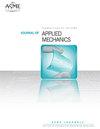Towards Tolerance Specifications for the Elastic Buckling Design of Axially Loaded Cylinders
IF 2.8
4区 工程技术
Q2 MECHANICS
引用次数: 0
Abstract
The quest for safe lower bounds to the elastic buckling of axially loaded circular cylindrical shells has exercised researchers for the past 100 years. Recent work bringing together the capabilities of non-linear numerical simulation, interpreted within the context of extended linear classical theory, has come close to achieving this goal of defining safe lower bounds. This paper briefly summarises important predictions from previous work and presents new simulations confirming them. In particular, we show that for a specified maximum amplitude of the most sensitive, eigenmode-based geometric imperfections, normalised with respect to the shell thickness, lower bounds to the buckling loads remain constant beyond a well-defined value of the Batdorf parameter. Furthermore, we demonstrate how this convenient means of presenting the imperfection-sensitive buckling loads can be reinterpreted to develop practical design curves providing safe, but not overly conservative, design loads for monocoque cylinders with a given maximum permitted tolerance of geometric imperfection. Hence, once the allowable manufacturing tolerance is specified during design or is measured post-manufacturing, the greatest expected knockdown factor for a shell of any geometry is defined. With the recent research interest in localised imperfections, we also attempt to reconcile their relation to the more classical, periodic, and eigenmode-based imperfections. Overall, this paper provides analytical and computational arguments that motivate a shift in focus in defect-tolerant design of thin-walled cylinders, away from the knockdown experienced for a specific geometric imperfection, towards the worst possible knockdown expected for a specified manufacturing tolerance.轴向载荷圆柱弹性屈曲设计公差规范探讨
对轴向载荷下圆柱壳弹性屈曲的安全下界的探索已经困扰了研究人员100多年。最近的工作将非线性数值模拟的能力结合在一起,在扩展的线性经典理论的背景下进行解释,已经接近实现定义安全下界的目标。本文简要总结了以往工作的重要预测,并提出了新的模拟来证实这些预测。特别是,我们表明,对于最敏感的,基于特征模态的几何缺陷的指定最大振幅,相对于壳厚度归一化,屈曲载荷的下界保持恒定,超出定义良好的Batdorf参数值。此外,我们还演示了如何重新解释这种方便的方法来表示对缺陷敏感的屈曲载荷,从而开发出实用的设计曲线,为具有给定最大几何缺陷允许容限的单体汽缸提供安全但不过于保守的设计载荷。因此,一旦在设计期间指定了允许制造公差或在制造后测量了公差,就可以定义任何几何形状壳体的最大期望击倒系数。随着最近对局部缺陷的研究兴趣,我们也试图调和它们与更经典的、周期的和基于特征模的缺陷的关系。总体而言,本文提供了分析和计算论据,激发了薄壁圆柱体容错设计的焦点转移,从特定几何缺陷的击倒经历转向指定制造公差预期的最坏的击倒。
本文章由计算机程序翻译,如有差异,请以英文原文为准。
求助全文
约1分钟内获得全文
求助全文
来源期刊
CiteScore
4.80
自引率
3.80%
发文量
95
审稿时长
5.8 months
期刊介绍:
All areas of theoretical and applied mechanics including, but not limited to: Aerodynamics; Aeroelasticity; Biomechanics; Boundary layers; Composite materials; Computational mechanics; Constitutive modeling of materials; Dynamics; Elasticity; Experimental mechanics; Flow and fracture; Heat transport in fluid flows; Hydraulics; Impact; Internal flow; Mechanical properties of materials; Mechanics of shocks; Micromechanics; Nanomechanics; Plasticity; Stress analysis; Structures; Thermodynamics of materials and in flowing fluids; Thermo-mechanics; Turbulence; Vibration; Wave propagation

 求助内容:
求助内容: 应助结果提醒方式:
应助结果提醒方式:


